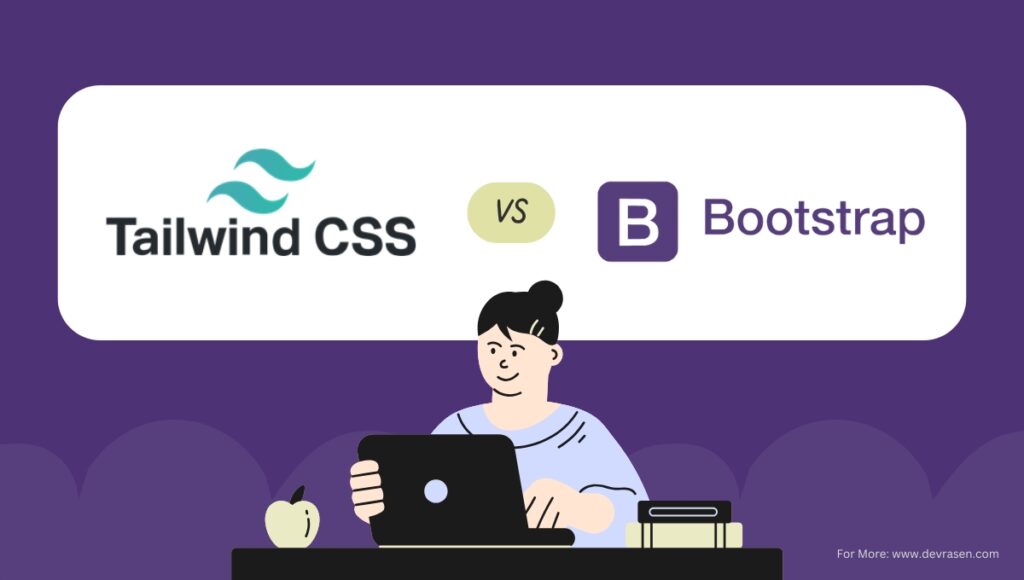The performance, functionality, and overall quality of your website can be significantly influenced by the CSS framework you use (Tailwind CSS vs. Bootstrap). Among the most popular choices are Tailwind CSS and Bootstrap, each offering distinct features and approaches to web development.
- Tailwind CSS stands out for its utility-first approach, providing complete control over designs, ideal for custom interfaces.
- Bootstrap, on the other hand, is renowned for its pre-built components and responsive grid system, making it the go-to for rapid development and consistent, reliable designs.

In this article, we’ll dive into the key features, pros, and cons of each framework, helping you decide which is better suited to your project needs and skill level.
What Is Tailwind CSS?
Tailwind CSS is a utility-first CSS framework that allows developers to build custom designs directly in HTML using predefined utility classes, without writing complex custom CSS. It’s perfect for projects requiring precision and uniqueness, offering complete freedom over elements like layout, colors, fonts, and spacing.

Key Features of Tailwind CSS
- Customizable Design: Tailwind provides a
tailwind.config.jsfile, allowing you to tweak the color scheme, fonts, spacing, and other design elements to fit any project. - Utility-First Classes: Instead of writing custom CSS, you apply utility classes directly in HTML (e.g.,
bg-blue-500,text-xl,p-4) to style elements. - Mobile-First: Tailwind supports responsive design with simple class prefixes like
md:andlg:, ensuring your layout adapts to different screen sizes.
Pros and Cons of Tailwind CSS
Pros:
- Highly Customizable: Tailwind offers extensive design flexibility through its configuration file.
- Utility-First Approach: Apply styling directly in HTML, eliminating the need for custom CSS.
- Lightweight: The framework purges unused styles, optimizing performance.
- Responsive: Easily adapt layouts to various screen sizes using responsive utilities.
- Time-Saving: Streamlines development by reducing repetitive CSS code.
Cons:
- Steep Learning Curve: The utility-first approach may be difficult for beginners.
- Cluttered HTML: Extensive utility class usage can lead to messy and hard-to-maintain HTML.
- No Pre-Built Components: Unlike Bootstrap, Tailwind requires you to build custom UI components.
- Manual Configuration: Complex design changes require a deeper understanding of Tailwind’s configuration options.
What Is Bootstrap?
Bootstrap is a widely used component-based CSS framework, providing an extensive collection of pre-built components and a responsive grid system. Developed by Twitter, Bootstrap is ideal for developers who need to build websites quickly, ensuring consistency and responsiveness.

Key Features of Bootstrap
- Pre-Built Components: Bootstrap offers a wide variety of pre-designed components like carousels, buttons, forms, modals, and navigation bars, saving time during development.
- Responsive Grid System: The 12-column grid system automatically adjusts layouts based on the screen size.
- Comprehensive Documentation: Bootstrap is known for its rich and organized documentation, making it easy for developers to get started.
- Customizable Themes: Bootstrap offers built-in variables to personalize layouts, colors, and fonts according to your project’s needs.
Pros and Cons of Bootstrap
Pros:
- Fast Development: Pre-built components and templates expedite the development process.
- Responsive Grid System: Automatically adapts to different screen sizes.
- Beginner-Friendly: With clear documentation, Bootstrap is ideal for developers at all skill levels.
- Consistency: Provides a uniform design across your website or application.
- Customizable: Modify styles using built-in variables and themes.
- Cross-Browser Compatibility: Works seamlessly across major browsers.
Cons:
- Limited Customization: Bootstrap’s default styles may require extensive overrides to create unique designs.
- Generic Look: Without significant customization, websites may end up looking similar to others.
- Large File Size: The unoptimized Bootstrap file can slow down your site.
- Cluttered HTML: Excessive use of utility classes can result in messy, hard-to-read code.
- Dependency on jQuery: Bootstrap’s JavaScript components rely on jQuery, which may be limiting for developers pre ferring a more modern, vanilla JavaScript approach.

Which One Should You Choose (Tailwind CSS vs. Bootstrap)?
The decision between Tailwind CSS and Bootstrap boils down to your project requirements and personal preferences:
- Choose Tailwind CSS if you prefer a utility-first approach with complete control over your design. It’s perfect for projects that demand customization, creative freedom, and a lean, performance-focused website. Tailwind is best for developers comfortable with more complex setups and configuration.
- Choose Bootstrap if you need to speed up development with pre-designed components and a responsive grid system. It’s ideal for rapid prototyping, especially for beginners, or for projects requiring consistent, reliable layouts with minimal setup. Bootstrap is perfect for websites or applications where time and consistency are essential.
Conclusion
Choosing between (Tailwind CSS vs. Bootstrap) ultimately depends on your unique project requirements. Both frameworks bring strengths to the table, and neither is inherently better than the other. The best choice is the one that aligns with your development style, project goals, and the level of customization you seek. Whether you value speed, simplicity, or complete control over your design, understanding the differences will help you make an informed decision. Consider your needs, preferences, and the complexity of the project to find the framework that works best for you.



